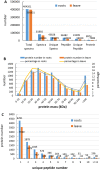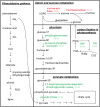iTRAQ-Based Quantitative Proteomic Analysis of Cotton Roots and Leaves Reveals Pathways Associated with Salt Stress
- PMID: 26841024
- PMCID: PMC4739606
- DOI: 10.1371/journal.pone.0148487
iTRAQ-Based Quantitative Proteomic Analysis of Cotton Roots and Leaves Reveals Pathways Associated with Salt Stress
Abstract
Salinity is a major abiotic stress that affects plant growth and development. In this study, we performed a proteomic analysis of cotton roots and leaf tissue following exposure to saline stress. 611 and 1477 proteins were differentially expressed in the roots and leaves, respectively. In the roots, 259 (42%) proteins were up-regulated and 352 (58%) were down-regulated. In the leaves, 748 (51%) proteins were up-regulated and 729 (49%) were down-regulated. On the basis of Gene Ontology (GO) and Kyoto Encyclopedia of Genes and Genomes (KEGG) pathway enrichment analysis, we concluded that the phenylalanine metabolism and starch and sucrose metabolism were active for energy homeostasis to cope with salt stress in cotton roots. Moreover, photosynthesis, pyruvate metabolism, glycolysis / gluconeogenesis, carbon fixation in photosynthetic organisms and phenylalanine metabolism were inhabited to reduce energy consumption. Characterization of the signaling pathways will help elucidate the mechanism activated by cotton in response to salt stress.
Conflict of interest statement
Figures




Similar articles
-
De novo transcriptome sequencing and comparative analysis of differentially expressed genes in Gossypium aridum under salt stress.Gene. 2013 Aug 1;525(1):26-34. doi: 10.1016/j.gene.2013.04.066. Epub 2013 May 4. Gene. 2013. PMID: 23651590
-
Global gene expression responses to waterlogging in roots and leaves of cotton (Gossypium hirsutum L.).Plant Cell Physiol. 2010 Jan;51(1):21-37. doi: 10.1093/pcp/pcp163. Epub 2009 Nov 18. Plant Cell Physiol. 2010. PMID: 19923201
-
Transcriptome-wide identification and stress properties of the 14-3-3 gene family in cotton (Gossypium hirsutum L.).Funct Integr Genomics. 2011 Dec;11(4):627-36. doi: 10.1007/s10142-011-0242-3. Epub 2011 Jul 31. Funct Integr Genomics. 2011. PMID: 21805362
-
Genome-wide analysis of chloride channel-encoding gene family members and identification of CLC genes that respond to Cl-/salt stress in upland cotton.Mol Biol Rep. 2020 Dec;47(12):9361-9371. doi: 10.1007/s11033-020-06023-z. Epub 2020 Nov 26. Mol Biol Rep. 2020. PMID: 33244663
-
Global gene expression in cotton (Gossypium hirsutum L.) leaves to waterlogging stress.PLoS One. 2017 Sep 27;12(9):e0185075. doi: 10.1371/journal.pone.0185075. eCollection 2017. PLoS One. 2017. PMID: 28953908 Free PMC article.
Cited by
-
Genome-wide association and differential expression analysis of salt tolerance in Gossypium hirsutum L at the germination stage.BMC Plant Biol. 2019 Sep 11;19(1):394. doi: 10.1186/s12870-019-1989-2. BMC Plant Biol. 2019. PMID: 31510912 Free PMC article.
-
iTRAQ-based quantitative proteomic analysis of salt stress in Spica Prunellae.Sci Rep. 2019 Jul 3;9(1):9590. doi: 10.1038/s41598-019-46043-9. Sci Rep. 2019. PMID: 31270436 Free PMC article.
-
Quantitative proteomic analysis using iTRAQ to identify salt-responsive proteins during the germination stage of two Medicago species.Sci Rep. 2018 Jun 22;8(1):9553. doi: 10.1038/s41598-018-27935-8. Sci Rep. 2018. PMID: 29934583 Free PMC article.
-
The photo-inhibition of camphor leaves (Cinnamomum camphora L.) by NaCl stress based on physiological, chloroplast structure and comparative proteomic analysis.PeerJ. 2020 Aug 7;8:e9443. doi: 10.7717/peerj.9443. eCollection 2020. PeerJ. 2020. PMID: 32974090 Free PMC article.
-
Effect of the Interaction between Elevated Carbon Dioxide and Iron Limitation on Proteomic Profiling of Soybean.Int J Mol Sci. 2022 Nov 7;23(21):13632. doi: 10.3390/ijms232113632. Int J Mol Sci. 2022. PMID: 36362418 Free PMC article.
References
-
- Nohzadeh Malakshah S, Habibi Rezaei M, Heidari M, Hosseini Salekdeh G. Proteomics reveals new salt responsive proteins associated with rice plasma membrane. Bioscience, Biotechnology, and Biochemistry. 2007; 71: 2144–2154. - PubMed
-
- Munns R. Genes and salt tolerance: bringing them together. New Phytologist. 2005; 167: 645–663. - PubMed
-
- Greenway H, Munns R. Mechanisnn of salt tolerance in non-halophytes. Annu Rev Plant Physiology. 1980: 149–190.
Publication types
MeSH terms
Substances
LinkOut - more resources
Full Text Sources
Other Literature Sources

